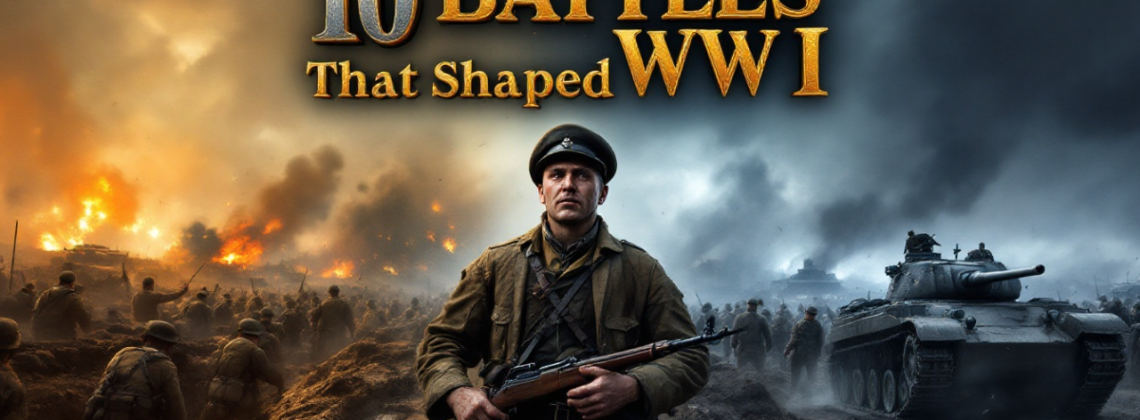
World War I, often referred to as “The Great War,” was a conflict of unparalleled brutality and significance. It reshaped the world map, toppled empires, and set the stage for the 20th century as we know it. But what truly defined this war? The answer lies within its battles, ten decisive clashes that became the crucibles of nations and the proving grounds of modern warfare. These battles weren’t just military engagements; they were moments that revealed the resilience, sacrifice, and innovation of those who fought. Join us as we explore the defining battles of World War I and the legacies they left behind. 🌟
1. Verdun: A Test of National Will
Verdun remains one of the most infamous battles of World War I. From February to December 1916, the German military launched “Operation Judgment” to “bleed France white.” For nearly 300 relentless days and nights, Verdun transformed into a harrowing landscape of craters, trenches, and unimaginable suffering. Poison gas, endless artillery barrages, and hand-to-hand combat made it a true war of attrition.
The French rallied behind the cry, “They shall not pass,” and against all odds, they held their ground. With casualties reaching an estimated 700,000, Verdun became a symbol of national endurance and sacrifice. This battle exemplified the horrors and futility of trench warfare, but it also forged a spirit of resilience in the French people.
2. The Somme: The Bloodiest Day in British Military History
On July 1, 1916, the Battle of the Somme began as a joint British-French offensive aimed at breaking the Western Front stalemate. Instead, it became synonymous with tragedy. The first day alone saw over 57,000 British casualties, marking one of the bloodiest days in military history.
While the battle introduced the world to the tank as a new weapon of war, it also underscored the devastating human cost of modern combat. By the time the battle ended in November, over a million men from both sides had become casualties. Though the Allies gained ground, the cost of the Somme remains a poignant reminder of the war’s toll.
3. Cambrai: The Dawn of Armored Warfare
November 1917 witnessed the Battle of Cambrai, where nearly 400 British tanks spearheaded an offensive against German lines. This innovative use of armored vehicles shattered initial German defenses and offered a glimpse of future warfare.
However, mechanical failures and logistical challenges stifled the British advance. A fierce German counterattack followed, turning a tactical victory into a strategic disappointment. Cambrai’s significance lies in its demonstration of tanks’ potential, foreshadowing their critical role in modern combat.
4. Amiens: The Black Day of the German Army
August 8, 1918, marked the beginning of the end for the German army. The Battle of Amiens introduced combined arms warfare, with tanks, infantry, and artillery working in unison. This coordinated assault by the Allies, bolstered by fresh American troops, caught German forces off guard.
German morale crumbled as their defenses gave way, and one officer lamented, “We are at a loss and can no longer offer resistance.” Amiens initiated the Hundred Days Offensive, which ultimately led to the war’s conclusion.
5. Megiddo: Victory in the Middle East
While Europe’s trenches dominated headlines, the Middle East saw a very different kind of warfare. In September 1918, British forces under General Edmund Allenby achieved a decisive victory at Megiddo. Utilizing infantry, cavalry, and air power, they shattered Ottoman defenses and effectively knocked the Ottoman Empire out of the war.
Megiddo showcased the power of maneuver warfare and opened the door for Allied advances into the heart of the Middle East, reshaping the region’s political future.
6. Tannenberg: Catastrophe on the Eastern Front
In August 1914, the Russian Second Army faced annihilation at Tannenberg. German commanders Paul von Hindenburg and Erich Ludendorff orchestrated a masterful encirclement, resulting in the capture or death of over 90,000 Russian troops.
General Alexander Samsonov, unable to face the defeat, took his own life. Tannenberg established German dominance on the Eastern Front and delivered a severe blow to Russian morale.
7. Gallipoli: A Campaign of Controversy
The Gallipoli Campaign of 1915 remains one of World War I’s most infamous military disasters. Allied forces, including Australian and New Zealand troops, attempted to seize the Dardanelles Strait but met fierce Turkish resistance.
Poor planning, disease, and relentless artillery fire turned the campaign into a nightmare. After months of suffering and heavy casualties, the Allies retreated, achieving none of their objectives. Gallipoli stands as a sobering lesson in the cost of poor strategy.
8. Jutland: The Clash of Titans
In May 1916, the British and German navies clashed in the North Sea at the Battle of Jutland. It was the largest naval battle of the war, featuring massive battleships called dreadnoughts exchanging fire over vast distances.
Though both sides claimed victory, Jutland was strategically significant for Britain, which maintained control of the seas. This ensured the continuation of the Allied naval blockade that crippled Germany’s economy and war effort.
9. Caporetto: Italy’s Darkest Hour
The Battle of Caporetto in October 1917 was a disaster for Italy. Austro-Hungarian and German forces launched a devastating offensive, causing the Italian army to collapse. Thousands of soldiers surrendered, and hundreds of thousands fled.
Caporetto not only cost Italy vast territory but also delivered a severe blow to national morale. Allied reinforcements eventually stabilized the front, but the battle remains a stark example of military failure.
10. The Marne: A Turning Point
In September 1914, the German advance toward Paris seemed unstoppable. But on the banks of the Marne River, French and British forces mounted a desperate counterattack. Even Parisian taxis were used to rush reinforcements to the front.
The Battle of the Marne halted the German advance and shattered hopes for a quick victory. It marked the beginning of the long, grueling trench warfare that would define the conflict.
Conclusion: Lessons from the Great War
From the killing fields of Verdun to the sweeping victories at Amiens and Megiddo, the battles of World War I shaped the modern world. These engagements were more than military clashes; they were transformative events that revealed the cost of conflict, the fragility of peace, and the resilience of the human spirit.
As we reflect on these battles, let us honor the sacrifices of those who fought and remember the lessons their struggles teach us about war and its consequences.
